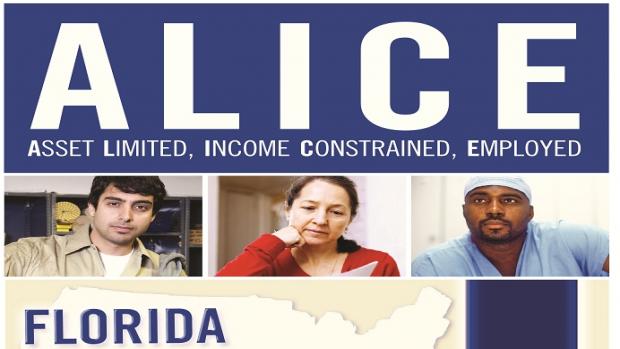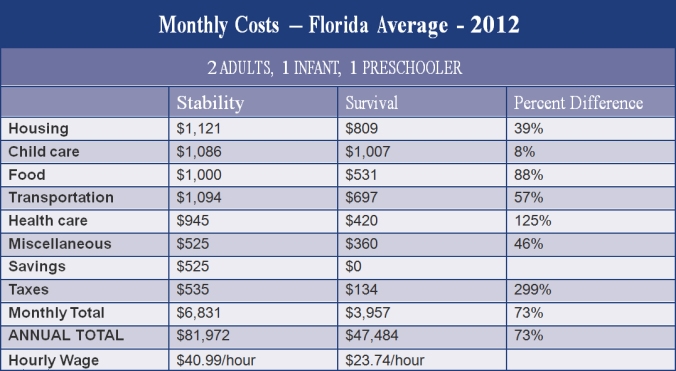
MR. RAYMOND OGLETHORPE, FOUNDER OF MOONSHOT MOMENT, WHOSE GOAL IS TO ACHIEVE 90% LITERACY BY THE THIRD GRADE, RECENTLY TURNED US ON TO THIS GROUNDBREAKING, THOUGH SHOCKING, STUDY BY THE UNITED WAY OF FLORIDA.
“It is a very informative report and has lots of implications to the IRCF (Indian River Community Foundation) and other IRC (Indian River County) non-profits, ” he wrote.
What’s shocking is that there are 3.2 million households in Florida and 45% are struggling to support themselves.
The study is called the ALICE project, the United Way of Florida’s broadest and fastest growing initiative.
The study is reported in 197 pages. We will try to summarize it here for you in 677 words.
ALICE is a United Way acronym for Asset Limited Income Constrained Employed.
The key word in the acronym is “employed,” because the project is about those who work, who are not unemployed, and who work hard, live paycheck to paycheck and have no reserve for a financial emergency.
The United Way’s ALICE study is groundbreaking because it has developed a “survival budget” for people in Florida who work. It is a survival budget for people who perhaps work several jobs, who live above the Federal Poverty Level, but who still cannot afford the basics of living, including housing, food, healthcare, child care, clothing and transportation. And who do not have any reserve for a financial emergency.
Nearly one in four Florida households make up this population.
In developing the ALICE project the United Way has partnered with Rutgers University – Newark’s School of Public Affairs and Administration (SPAA). SPAA is ranked 10th nationally in public management and administration.
Here is where the study is shocking.
The annual household survival budget for the average family is $ 47,484 and for a single adult $18,624, as illustrated below:

According to the study, “these numbers highlight the inadequacy of the US poverty rate as a measure of economic viability at $ 23,050 for a family and $ 11,170 for a single adult.
The official Florida poverty rate of 15% obscures the magnitude of financial instability in the State.” Particularly since the US poverty rate, developed in 1965, has not been updated since 1974.
The annual household “stability budget,” one that enables not just survival, but self-sufficiency in Florida, is almost double the household survival budget for a family of four at $ 81,972 per year and $ 24,764 for a single adult, as illustrated below:

Florida has 2.1 million households that have income above the Federal Poverty Level, but below the ALICE survival threshold. Once again, there are 3.2 million households in Florida and 45% are struggling to support themselves.
But these are people who hold jobs, multiple jobs, pay taxes and provide services vital to the Florida economy, such as retail salespeople, laborers, movers and home health aides.
Unfortunately, however, while hard working people in Florida hold these jobs, 69% of all jobs here pay less than $ 20/hour and 54% pay less than $ 15/hour.
According to the ALICE report, here are the consequences:
- Parents cannot afford accredited childcare
- People are skipping preventative healthcare
- People are moving out of state
- Couples are delaying having children
- No one is saving
- People are skimping on toiletries and cleaning supplies
- People are skipping healthy food
- People are forgoing car insurance
And here are the impacts:
- Absenteeism
- Less productive workers
- Poor health / Daily functioning workers
- Unsafe vehicles on the road
- Community disruption
The ALICE study also ranked housing affordability, job opportunities and community support on a county-by-county basis.
In Indian River County (IRC), in terms of housing affordability, where scores ranged from 13 – 71 IRC received a fair grade at 51.
IRC job opportunities, where scores ranged from 34 – 70, IRC ranked poor at 34.
IRC ranked fair in terms of community support, at 54, out of a range of 30-80.
Unfortunately the United Way’s study about how 45% of Florida’s households are struggling is a growing problem because Florida’s population is growing. Florida’s population grew 49% from 1999 to 2012 and it is expected to exceed the overall US rate between 2010 and 2020.